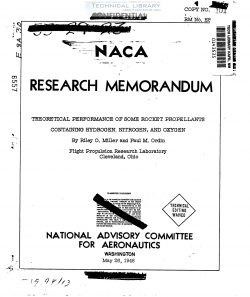naca-rm-e8a30
- Version
- 94 Downloads
- 1.76 MB File Size
- 1 File Count
- April 21, 2017 Create Date
- April 21, 2017 Last Updated
National Advisory Committee for Aeronautics, Research Memorandum - Theoretical Performance of Some Rocket Propellants Containing Hydrogen, Nitrogen, and Oxygen

Theoretical performance data based on frozen equilibrium and
isentropic expansion are presented for ranges of mixtures for a num-
ber of propellant combinations at a reaction pressure of 500 pounds
per square inch absolute and an expansion ratio of 20.4. The fuels
considered. are liquid hydrogen, hydrazine, liquid ammonia, hydrazine
hydrate, and hydroxylamine; the oxidants are liquid ozone, liquid
oxygen, and loo-percent hydrogen peroxide. The theoretical data
include nozzle-exit temperature, specific impulse, volume specific
impulse, and composition, temperature, and mean molecular weight of
the reaction products.
The maximum specific impulse for most of the propellants
occurred in the fuel-rich region at a reaction-chamber temperature
less than the maximum. Maximum volume specific impulse did or did
not occur at the point of maximum specific impulse, depending on
the relative density of the fuel and oxidant. On the basis of max-
imum specific impulse alone, the five fuels assumed the following
order for any given oudant: liquid hydrogen, hydrazine, liquid
ammonia, and. either hydrazine hydrate or hydroxylamine; and the
three oxidants with a given fuel had the following order: liquid
ozone, liquid oxygen, and loo-percent hydrogen peroxide. 0n the
basis of maximum volume specific impulse alone, the order of the
fuels with a given oxidant was hydrazine, hydroxylamine, hydrazine
hydrate, liquid ammonia, and liquid hydrogen. With a given fuel,
except for ammonia, the oxidant order was: liquid ozone,
loo-percent hydrogen peroxide, and liquid oxygen; with ammonia the
order, however, was loo-percent hydrogen peroxide, liquid ozone,
and liquid oxygen.
Rocket-propellant performance is evaluated by a number of fac-
tors and the relative importance of each factor is governed by the
particular application of the craft powered by the rocket engine.
A large amount of thrust is desired for a given mass consumption
rate of the working fluid (specific impulse). If aerodynamic drag
is an important consideration, the rocket propellants should have
high densities to give high thrust per unit volume (volume specific
impulse). Because of the cooling problem, a low reaction tempera-
ture is also desirable. Inasmuch as specific impulse is approxi-
mately proportional to the square root of the quotient of gas tem-
perature by mean molecular weight of the reaction products, an
increase in specific impulse is more desirably obtained by decreasing
the mean molecular weight than by increasing the gas temperature.
| File | Action |
|---|---|
| naca-rm-e8a30 Theoretical Performance of Some Rocket Propellants Containing Hydrogen, Nitrogen, and Oxygen.pdf | Download |

Comment On This Post